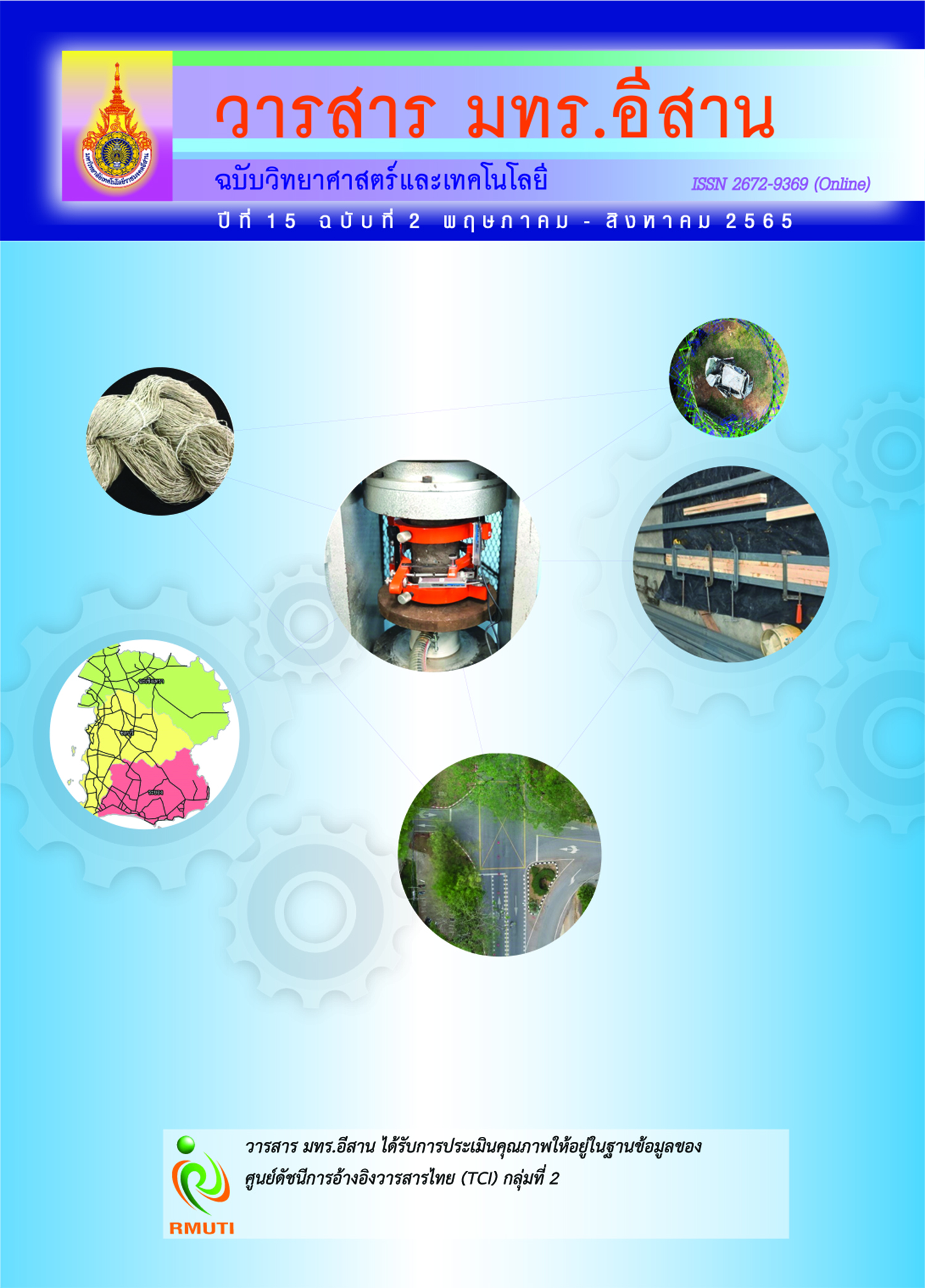Comparison of Retaining Walls from Half-Panel Interlocking Bricks with Dry Joints Reinforced with GFRP Material and Stud Steel
Main Article Content
Abstract
This research aimed to compare a half-panel interlocking brick retaining wall model reinforced with GFRP material against one reinforced with steel stud. To study the behavior of horizontal movement of the retaining walls, a model with the size of 1.60 meter height and 2.00 meter width was reinforced with GFRP material and steel stud of compressive strength of 10, 20, and 30 lbs. Lateral soil pressure was applied and it transmitted the settlement of sand in the steel model after which its horizontal displacement was considered. The test results of the half-panel interlocking bricks with dry junction reinforced with GFRP material had the highest horizontal displacement values of 4.87, 3.82, and 3.25 millimeters, respectively, and showed higher values than those of steel stud reinforced samples by 4.74, 5.40, and 7.05 millimeter, respectively. The GFRP reinforced material showed less horizontal movement compared to those of reinforced with steel stud by 30.92, 29.26, and 31.33 %, respectively.
Article Details

This work is licensed under a Creative Commons Attribution-NonCommercial-NoDerivatives 4.0 International License.
References
Suksan, H. (2552). Foundation Engineering. Krongchang Printing Co., Ltd.
Prongmanee, N. and Noulmanee, A. (2020). Properties of Chiang Khruea Lateritic Soil and Their Applications in Civil Engineering. RMUTI Journal Science and Technology. Vol. 13, No. 3, pp. 14-30 (in Thai)
Rahmaninezhad, S. M. and Han, J. (2021). Lateral Facing Deflections of Geosynthetic-Reinforced Retaining Walls Under Footing Loading. Transportation Geotechnics. Vol. 30, p. 100594. DOI: 10.1016/J.TRGEO.2021.100594
Gao, J., Liu, L., Zhang, Y., and Xie, X. (2022). Deformation Mechanism and Soil Evolution Analysis Based on Different Types Geogrid Reinforced Foundation. Construction and Building Materials. Vol. 331, p. 127322. DOI: 10.1016/j.conbuildmat.2022.127322
Li, L. H., Yu, C. D., Xiao, H. L., Feng, W. Q., Ma, Q., and Yin, J. H. (2020). Experimental Study on the Reinforced Fly Ash and Sand Retaining Wall Under Static Load. Construction and Building Materials. Vol. 248, p. 118678. DOI: 10.1016/j.conbuildmat.2020.118678
Arefnia, A., Dehghanbanadaki, A., and Kassim, K. A. (2021). Sustainable Implementation of Recycled Tire-Derived Aggregate as a Lightweight Backfill for Retaining Walls. KSCE Journal of Civil Engineering. Vol. 25, No. 11, pp. 4196-4206. DOI: 10.1007/s12205-021-0218-3
Wang, J. Q., Zhang, L. L., Tang, Y., and Huang, S. B. (2021). Influence of Reinforcement-Arrangements on Dynamic Response of Geogrid-Reinforced Foundation Under Repeated Loading. Construction and Building Materials. Vol. 274, p. 122093. DOI: 10.1016/j.conbuildmat.2020.122093
Liu, S., Fan, K., and Xu, Si. (2021). Field Study of a Retaining Wall Constructed with Clay-Filled Soilbags. Geotextiles and Geomembranes. Vol. 47, Issue 1, pp. 87-94. DOI: 10.1016/j.geotexmem.2018.11.001
Villemus, B., Morel, J. C., and Boutin, C. (2007). Experimental Assessment of Dry Stone Retaining Wall Stability on a Rigid Foundation. Engineering Structures. Vol. 29, No. 9, pp. 2124-2132
Colas, A. S., Morel, J. C., and Garnier, D. (2010). Full-Scale Field Trials to Assess Dry-Stone Retaining Wall Stability. Engineering Structures. Vol. 32, Issue 5, pp. 1215-1222
Mundell, C., McCombie, P., Ms, A., Harkness, J., Walker, P., and Mieaust, C. (2010). Behaviour of Drystone Retaining Structures. In Proceedings of the Institution of Civil Engineers - Structures and Buildings. Vol. 163, Issue 1, pp. 3-12. DOI: 10.1680/stbu.2009.163.1.3
Colas, A. S. (2013). Productivity Model Design of Dry Joint Fastening Structures. Doctorate of Dissertation Universite Gustave Eiffel
Hanjitsuwan, S., Tho-in, T., and Phoo-ngernkham, T. (2021). Influence of NaOH Concentration and Sand to Binder Ratio on Hybrid Cement Mortar for Filled Materials in Notched Concrete Beam. RMUTI Journal Science and Technology. Vol. 15, No. 1,
pp. 1-10 (in Thai)
MSU 602/2547. (2004). Community Product Standard. Thai Industrial Standards Institute
Nanni, A. (2003). North American Design Guidelines for Concrete Reinforcement and Strengthening Using FRP: Principles, Applications and Unresolved Issues. Construction and Building Materials. Vol. 17, Issue 6-7, pp. 439-446. DOI: 10.1016/S0950-0618(03)00042-4
Hamzeh, L., Hassanein, A., and Galal, K. (2020). Numerical Study on the Seismic Response of GFRP and Steel Reinforced Masonry Shear Walls with Boundary Elements. Structures. Vol. 28, pp. 1946-1964
Ceroni, F., Cuzzilla, R., and Pecce, M. (2016). Assessment of Performance of Steel and GFRP Bars as Injected Anchors in Masonry Walls. Construction and Building Materials. Vol. 123, pp. 78-98
Ketkan, W. and Khamphala, A. (2010). A Model of Maximum Pullout Force of Bearing Reinforcement Stabilized on Compacted Sandy Soil. RMUTI Journal. Vol. 3, No. 1, pp. 1-9 (in Thai)
Thumrongvut, J., Seangatith, S., and Kumlue, K. (2013). Tests on Structural Behaviors of Precast Partially-Prestressed Concrete Beam's Joints. RMUTI Journal. Vol. 6, No. 2, pp. 15-30 (in Thai)
ASTM C136-06. (2015). Standard Test Method for Sieve Analysis of Fine and Coarse Aggregates. Annual Book of ASTM Standard. Vol.04.02.
ASTM A193 Grade B16. (2015). A Grade Specification for Low Alloy Chromium-Molybdenum-Vanadium Steel. Annual Book of ASTM Standard. Vol.04.02.
ACI 318-19. (2019). Building Code Requirements for Reinforced Concrete. American Concrete Institute
Pongsagorn, P., Tanakrit, B., and Attaphol, B. (2019). Strength and Behaviors of Dry-Joint Retaining Nano-Block. International Journal of Geomate. Vol. 16, No. 54, pp. 42-48


